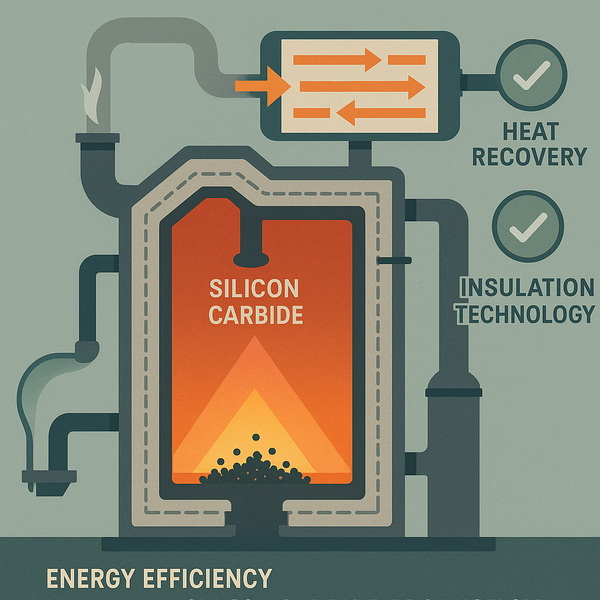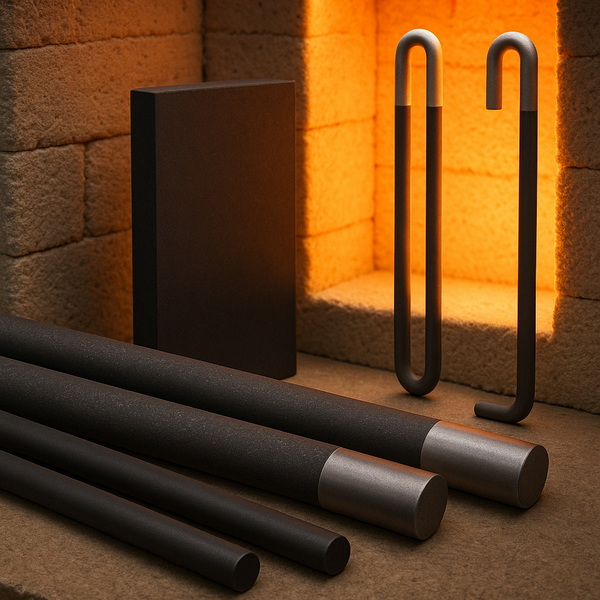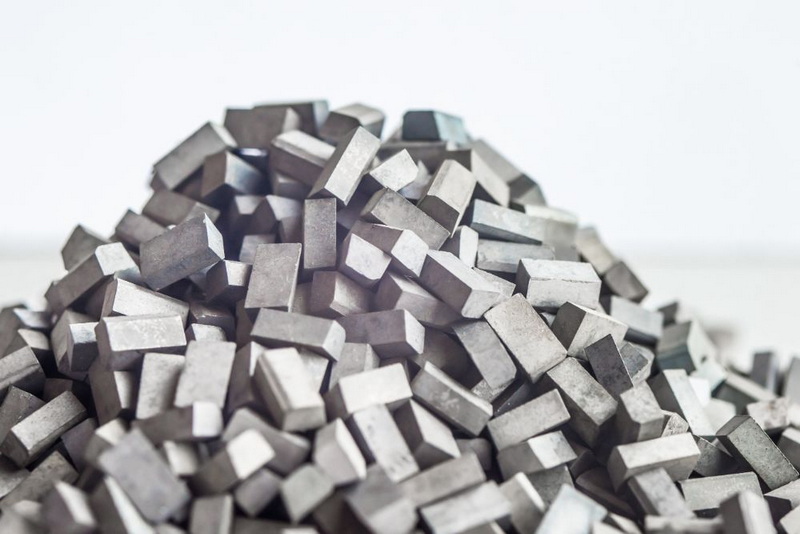Content Menu
● Introduction to Silicon Carbide Production Furnaces
● Core Features of a Silicon Carbide Production Furnace
>> 1. High-Temperature Capability
>> 2. Precise Temperature Control
>> 3. Versatile Heating Elements
>> 4. Controlled Atmosphere
>> 5. Robust Construction Materials
>> 6. Automation and Safety Systems
● Types of Silicon Carbide Production Furnaces
>> Acheson Furnace
>> Sintering Furnace
>> Vertical and Rotary Tube Furnaces
>> Continuous Belt Furnaces
● Heating Elements: The Backbone of SiC Furnaces
>> Silicon Carbide Heating Elements
>> Graphite Heating Elements
>> Molybdenum Disilicide (MoSi₂) Elements
>> Element Arrangement and Replacement
● Temperature Control and Uniformity
>> Thermal Management Systems
● Furnace Atmosphere and Environmental Controls
>> Atmosphere Monitoring
● Construction Materials and Furnace Design
>> Insulation Technology
● Automation, Safety, and Maintenance Features
>> Predictive Maintenance
● Energy Efficiency and Sustainability in SiC Furnaces
● Applications Across Industries
● Challenges and Limitations
● Future Trends in Silicon Carbide Furnace Technology
● Conclusion
● FAQ: Top 5 Questions About Silicon Carbide Production Furnaces
>> 1. What is the maximum temperature a silicon carbide production furnace can achieve?
>> 2. What types of heating elements are used in silicon carbide production furnaces?
>> 3. How is temperature uniformity maintained in these furnaces?
>> 4. What are the main maintenance challenges for silicon carbide production furnaces?
>> 5. Can silicon carbide production furnaces operate under different atmospheres?
Silicon carbide (SiC) is a critical material for a wide range of industrial, military, metallurgical, petroleum drilling, mining, and construction applications. The heart of any silicon carbide production line is the silicon carbide production furnace—a sophisticated piece of equipment designed to withstand extreme temperatures and deliver precise, high-quality SiC products. This article explores the essential features, design considerations, and technological advancements that define a modern silicon carbide production furnace.

Introduction to Silicon Carbide Production Furnaces
Silicon carbide is synthesized by reacting silica (SiO₂) with carbon (C) at extremely high temperatures, typically in the range of 1,800°C to 2,500°C. This process requires a specialized furnace capable of maintaining such conditions for prolonged periods, ensuring the complete transformation of raw materials into high-purity SiC.
A silicon carbide production furnace is not just a high-temperature oven; it is a carefully engineered system that balances temperature, atmosphere, material flow, and energy efficiency to produce SiC with the desired properties for demanding applications.
Core Features of a Silicon Carbide Production Furnace
1. High-Temperature Capability
The furnace must achieve and maintain temperatures up to 2,500°C, essential for the carbothermic reduction of silica and the subsequent growth of silicon carbide crystals. Advanced insulation and robust heating elements are required to handle such intense heat without structural degradation.
2. Precise Temperature Control
Uniform and precise temperature control is crucial for consistent SiC quality. Modern furnaces employ multi-zone temperature controllers and advanced sensors to monitor and regulate heat distribution, minimizing thermal gradients and ensuring uniform crystal growth.
3. Versatile Heating Elements
Silicon carbide furnaces typically use SiC heating elements, graphite heaters, or molybdenum disilicide (MoSi₂) elements, each offering unique advantages in terms of temperature range, efficiency, and lifespan. SiC heating elements are self-supporting, capable of high watt loadings, and can be replaced while the furnace is hot, reducing downtime.
4. Controlled Atmosphere
The furnace atmosphere can be tailored—vacuum, inert gas, or oxidizing—depending on the desired SiC product and process requirements. Advanced furnaces feature gas-tight chambers and atmosphere control systems to prevent contamination and optimize reaction conditions.
5. Robust Construction Materials
Furnace linings and structural components are made from high-melting-point, chemically inert materials such as graphite, high-purity ceramics, and stainless steel to withstand prolonged exposure to extreme temperatures and reactive environments. Composite wall structures with multiple layers of insulation and heat-resistant materials ensure energy efficiency and operator safety.
6. Automation and Safety Systems
Modern SiC furnaces integrate programmable logic controllers (PLCs), PID temperature controllers, and safety interlocks for precise operation and protection against overheating or system failures. Automated loading, unloading, and maintenance features improve productivity and reduce manual intervention.
Types of Silicon Carbide Production Furnaces
Acheson Furnace
The traditional Acheson furnace is the most widely used for bulk SiC production. It consists of a large horizontal chamber filled with a mixture of silica sand and carbon, with a central graphite resistor that acts as the heating element. Electric current passes through the resistor, generating the high temperatures needed for the reaction.
Sintering Furnace
Used for producing dense, high-purity SiC ceramics and components. These furnaces often feature vacuum or controlled atmosphere capabilities, precision temperature control, and advanced heating elements such as graphite tubes or SiC rods.
Vertical and Rotary Tube Furnaces
Designed for continuous or batch processing of SiC powders and components. Vertical furnaces are ideal for thermal treatments such as doping, oxidation, and annealing, while rotary tube furnaces enable uniform heating and mixing for powder synthesis.
Continuous Belt Furnaces
For large-scale, automated production, continuous belt furnaces move SiC materials through different temperature zones on a conveyor belt. This design allows for high throughput, consistent product quality, and reduced labor costs.

Heating Elements: The Backbone of SiC Furnaces
Silicon Carbide Heating Elements
Offer high thermal conductivity, stability at elevated temperatures, and resistance to oxidation. Available in various shapes and sizes (rods, tubes, U-shaped, spiral, etc.) to suit different furnace designs. Capable of operating up to 1,625°C and beyond, with some advanced designs reaching even higher.
Graphite Heating Elements
Preferred for ultra-high-temperature applications (up to 2,350°C) and in furnaces where a reducing atmosphere is required. Long service life, good heating effect, and convenient maintenance.
Molybdenum Disilicide (MoSi₂) Elements
Used in vertical furnaces for specialized processes, offering excellent performance at high temperatures and in oxidizing atmospheres.
Element Arrangement and Replacement
Heating elements are arranged to maximize temperature uniformity and energy efficiency. Modular designs allow for easy replacement, minimizing downtime and maintenance costs.
Temperature Control and Uniformity
Multi-zone temperature controllers ensure even heat distribution throughout the furnace chamber, critical for producing SiC with uniform properties. Optical pyrometers and thermocouples are strategically placed for real-time monitoring, enabling rapid adjustments and minimizing thermal shock risks. Temperature uniformity is typically maintained within ±5°C, with some advanced systems achieving even tighter tolerances.
Thermal Management Systems
Advanced furnaces employ active cooling systems, such as water jackets or air cooling, to protect sensitive components and maintain structural integrity. These systems are vital for long-term reliability and safety.
Furnace Atmosphere and Environmental Controls
The ability to operate under vacuum or inert gas (e.g., argon, nitrogen) is essential for preventing unwanted reactions and achieving high-purity SiC. Dewaxing systems and atmosphere purifiers enhance process stability and extend the service life of furnace components. Emissions control systems capture and process byproducts such as carbon monoxide, reducing environmental impact.
Atmosphere Monitoring
Continuous monitoring of gas composition and pressure ensures optimal reaction conditions and product quality. Automated valves and purging systems help maintain the desired atmosphere throughout the production cycle.
Construction Materials and Furnace Design
Furnace bodies are constructed from stainless steel with dual-layer water jackets for cooling and safety. Internal hot zones are lined with high-temperature ceramics or graphite to resist chemical attack and thermal cycling. Modular designs allow for easy maintenance, replacement of heating elements, and scalability for different production capacities.
Insulation Technology
High-performance insulation materials, such as ceramic fiber boards and refractory bricks, minimize heat loss and improve energy efficiency. Multi-layer insulation systems are commonly used to achieve the best balance between thermal performance and durability.
Automation, Safety, and Maintenance Features
PLCs and advanced user interfaces enable programmable temperature profiles, automatic shutdowns, and remote monitoring. Safety interlocks prevent operation under unsafe conditions, such as overtemperature or atmosphere leaks. Periodic inspection routines, easy access panels, and group replacement of heating elements streamline maintenance and reduce downtime.
Predictive Maintenance
Some modern furnaces incorporate sensors and data analytics to predict component wear and schedule maintenance before failures occur, further improving reliability and reducing unplanned outages.
Energy Efficiency and Sustainability in SiC Furnaces
Energy consumption is a significant consideration in silicon carbide production. Modern silicon carbide production furnaces are designed with energy-saving features, such as:
- High-Efficiency Heating Elements: Advanced materials and designs reduce energy loss and improve conversion efficiency.
- Heat Recovery Systems: Waste heat from the furnace can be captured and reused for preheating raw materials or other processes, reducing overall energy demand.
- Smart Controls: Automated systems optimize power usage based on real-time data, adjusting heating cycles for maximum efficiency.
- Insulation Upgrades: Improved insulation reduces heat loss, lowering energy consumption and operating costs.
Sustainability is also addressed through emissions controls, recycling of byproducts, and the use of renewable energy sources where possible.
Applications Across Industries
Silicon carbide production furnaces are indispensable in:
- Industrial Manufacturing: Abrasives, refractories, and wear-resistant components.
- Military: Armor, high-performance electronics, and missile components.
- Metallurgy: Crucibles, linings, and high-temperature tools.
- Petroleum Drilling: Drill bits and wear parts.
- Mining Tools: Cutting, grinding, and drilling equipment.
- Construction: Reinforced concrete, flooring, and structural elements.
- Semiconductor Industry: SiC wafers for power electronics and high-frequency devices.
The versatility of silicon carbide, combined with the advanced capabilities of modern furnaces, makes SiC a material of choice for demanding environments where performance and reliability are paramount.
Challenges and Limitations
While silicon carbide production furnaces offer numerous advantages, they also face several challenges:
- Thermal Shock Sensitivity: Rapid temperature changes can cause cracking or failure of SiC components, requiring careful ramp-up and cool-down procedures.
- Corrosion Resistance: SiC can be attacked by certain chemicals and oxidizing environments at high temperatures, necessitating protective coatings or alternative materials in some cases.
- High Production Costs: The need for high-purity raw materials and advanced furnace components increases operational expenses.
- Maintenance Demands: SiC heating elements experience resistance increases and eventual degradation, requiring regular monitoring and replacement.
- Scale-Up Complexity: Scaling furnace designs for larger production volumes while maintaining uniformity and quality can be technically challenging.
Future Trends in Silicon Carbide Furnace Technology
As demand for silicon carbide continues to grow, furnace technology is evolving rapidly. Key trends include:
- Digital Integration: The use of IoT sensors, cloud-based monitoring, and AI-driven process optimization is making furnaces smarter and more responsive.
- Advanced Materials: New refractory and insulation materials are extending furnace lifespans and reducing maintenance needs.
- Modular and Scalable Designs: Flexible furnace architectures allow for easy expansion and adaptation to changing production requirements.
- Green Manufacturing: Emphasis on energy efficiency, waste reduction, and emissions control is driving innovation in furnace design and operation.
These trends are shaping the next generation of silicon carbide production furnaces, ensuring they remain at the forefront of industrial technology.
Conclusion
A silicon carbide production furnace is a marvel of modern engineering, combining extreme temperature capability, precise control, robust construction, and advanced automation to produce one of the most versatile and valuable materials in industry today. As technology advances, these furnaces continue to evolve—offering greater efficiency, reliability, and environmental performance. For any organization involved in the production, processing, or application of silicon carbide, understanding the key features of a silicon carbide production furnace is essential for achieving optimal results and maintaining a competitive edge.

FAQ: Top 5 Questions About Silicon Carbide Production Furnaces
1. What is the maximum temperature a silicon carbide production furnace can achieve?
Most silicon carbide production furnaces can reach temperatures up to 2,500°C, which is necessary for the carbothermic reduction of silica and the formation of high-quality silicon carbide crystals.
2. What types of heating elements are used in silicon carbide production furnaces?
The most common heating elements are silicon carbide rods, graphite heaters, and molybdenum disilicide (MoSi₂) elements. The choice depends on the required temperature, atmosphere, and process specifics.
3. How is temperature uniformity maintained in these furnaces?
Multi-zone temperature controllers, advanced sensors, and carefully designed heating element arrangements ensure even heat distribution, minimizing thermal gradients and ensuring consistent SiC quality.
4. What are the main maintenance challenges for silicon carbide production furnaces?
SiC heating elements gradually increase in resistance and may fracture over time, requiring regular inspection and replacement. Maintaining a clean furnace atmosphere and proper installation also extends component life.
5. Can silicon carbide production furnaces operate under different atmospheres?
Yes, modern furnaces can operate under vacuum, inert gas, or oxidizing atmospheres, depending on the desired SiC product and process requirements. Atmosphere control is critical for product purity and furnace longevity.















